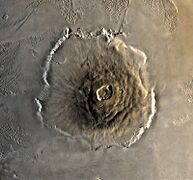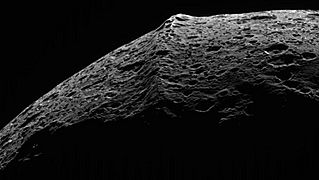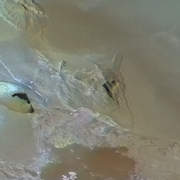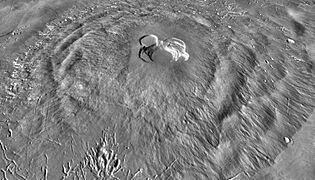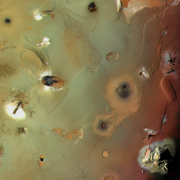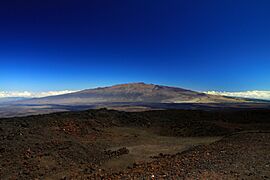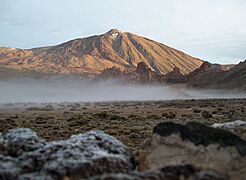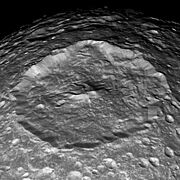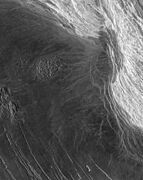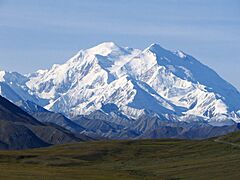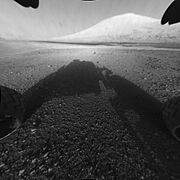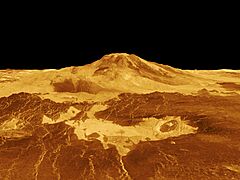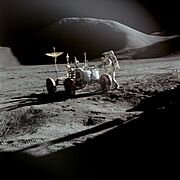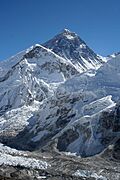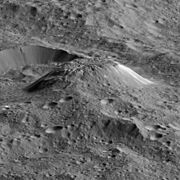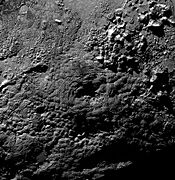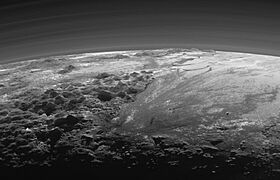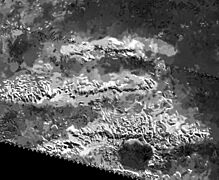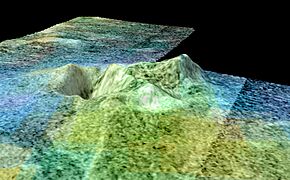List of tallest mountains in the Solar System facts for kids

Welcome to a journey across our amazing Solar System! Here, we'll explore the tallest mountains found on different planets, moons, and even asteroids. These incredible peaks are measured from their base to their highest point. Scientists have found many huge mountains on various space objects.
The tallest mountain in our Solar System might be Olympus Mons on Mars. It stands an incredible 21.9 to 26 kilometers (13.6 to 16.2 miles) high! Another contender for the tallest is the central peak of Rheasilvia on the asteroid Vesta, which is estimated to be between 19 and 22 kilometers (11.8 to 13.7 miles) tall from its base.
A Tour of Solar System Peaks
The heights listed here are measured from the bottom of the mountain (its base) all the way to its very top (its peak). On Earth, we often measure mountains from sea level, but in space, there's no "sea level" on most planets! So, for other planets and moons, scientists measure from the mountain's base.
| Planet | Tallest peak(s) | Base-to-peak height | % of radius | Origin | Notes |
|---|---|---|---|---|---|
| Mercury | Caloris Montes | ≤ 3 km (1.9 mi) | 0.12 | Impact (from a space rock hitting) | Formed when a giant space rock hit Mercury, creating the Caloris Basin. |
| Venus | Skadi Mons (Maxwell Montes massif) | 6.4 km (4.0 mi) (11 km above mean) | 0.11 | Tectonic (from the planet's crust moving) | Its slopes look shiny on radar, possibly due to special "Venus snow." |
| Maat Mons | 4.9 km (3.0 mi) (approx.) | 0.081 | Volcanic | This is the tallest volcano on Venus. | |
| Earth | Mauna Kea and Mauna Loa | 10.2 km (6.3 mi) | 0.16 | Volcanic | About 4.2 km (2.6 miles) of this mountain is above sea level. |
| Haleakalā | 9.1 km (5.7 mi) | 0.14 | Volcanic | It rises 3.1 km (1.9 miles) above sea level. | |
| Pico del Teide | 7.5 km (4.7 mi) | 0.12 | Volcanic | It rises 3.7 km (2.3 miles) above sea level. | |
| Denali (Mount McKinley) | 5.3 to 5.9 km (3.3 to 3.7 mi) | 0.093 | Tectonic (from Earth's crust folding) | This is the tallest mountain on land when measured from its base to its peak. | |
| Mount Everest | 3.6 to 4.6 km (2.2 to 2.9 mi) | 0.072 | Tectonic (from Earth's crust folding) | It's 4.6 km (2.9 miles) on its north side and 3.6 km (2.2 miles) on its south side. It has the highest elevation above sea level at 8.8 km (5.5 miles). | |
| Moon | Mons Huygens | 5.3 km (3.3 mi) | 0.31 | Impact | Formed by the huge Imbrium impact event. |
| Mons Mouton | 6 km (3.7 mi) | 0.35 | Impact | Likely formed by the South Pole-Aitken basin impact. | |
| Southern Farside Mountain | 7 km (4.3 mi) | 0.40 | Impact | This is the Moon's tallest free-standing mountain. It might have formed from the South Pole-Aitken basin impact. | |
| Mons Hadley | 4.5 km (2.8 mi) | 0.26 | Impact | Formed by the Imbrium impact event. | |
| Mons Rümker | 1.3 km (0.81 mi) | 0.063 | Volcanic | The biggest volcanic structure found on the Moon. | |
| Mars | Olympus Mons | 21.9–26 km (13.6–16.2 mi; 72,000–85,000 ft) | 0.65 | Volcanic | This is the tallest mountain in our Solar System! It's a shield volcano with very gentle slopes, and its top has huge craters called calderas. |
| Ascraeus Mons | 14.9 km (9.3 mi) | 0.44 | Volcanic | The tallest of the three Tharsis Montes volcanoes. | |
| Elysium Mons | 12.6 km (7.8 mi) | 0.37 | Volcanic | The highest volcano in the Elysium region. | |
| Arsia Mons | 11.7 km (7.3 mi) | 0.35 | Volcanic | Its summit has a caldera (a large crater) that is 108 to 138 km (67 to 86 miles) wide. | |
| Pavonis Mons | 8.4 km (5.2 mi) | 0.25 | Volcanic | Its summit caldera is 4.8 km (3 miles) deep. | |
| Anseris Mons | 6.2 km (3.9 mi) | 0.18 | Impact | One of the tallest non-volcanic mountains on Mars, formed by the Hellas impact. | |
| Aeolis Mons ("Mount Sharp") | 4.5 to 5.5 km (2.8 to 3.4 mi) | 0.16 | Formed by layers of sediment and wind erosion | Formed from deposits in Gale crater; the MSL rover has been climbing it since November 2014. | |
| Vesta | Rheasilvia central peak | 20–25 km (12–16 mi; 66,000–82,000 ft) | 8.4 | Impact | This peak is almost 200 km (124 miles) wide. |
| Ceres | Ahuna Mons | 4 km (2.5 mi) | 0.85 | Cryovolcanic (ice volcano) | An isolated, steep-sided dome in a relatively smooth area. |
| Io | Boösaule Montes "South" | 17.5 to 18.2 km (10.9 to 11.3 mi) | 1.0 | Tectonic (from the moon's crust moving) | It has a 15 km (9.3 miles) high cliff on its southeast side. |
| Ionian Mons east ridge | 12.7 km (7.9 mi) (approx.) | 0.70 | Tectonic (from the moon's crust moving) | This mountain has a curved double ridge shape. | |
| Euboea Montes | 10.5 to 13.4 km (6.5 to 8.3 mi) | 0.74 | Tectonic (from the moon's crust moving) | A huge landslide on its side left a massive pile of debris. | |
| unnamed (245° W, 30° S) | 2.5 km (1.6 mi) (approx.) | 0.14 | Volcanic | One of Io's many volcanoes, with an unusual cone shape. | |
| Mimas | Herschel central peak | 7 km (4 mi) (approx.) | 3.5 | Impact | This peak is in the middle of the giant Herschel crater. |
| Dione | Janiculum Dorsa | 1.5 km (0.9 mi) | 0.27 | Tectonic (from the moon's crust moving) | The crust around it is pushed down by about 0.3 km (0.2 miles). |
| Titan | Mithrim Montes | ≤ 3.3 km (2.1 mi) | 0.13 | Tectonic (from the moon's crust moving) | May have formed because the moon's surface shrank. |
| Doom Mons | 1.45 km (0.90 mi) | 0.056 | Cryovolcanic (ice volcano) | It is next to Sotra Patera, a deep collapse feature. | |
| Iapetus | equatorial ridge | 20 km (12 mi) (approx.) | 2.7 | Uncertain | Scientists are still unsure how this unique ridge formed. Individual peaks along it have not been measured. |
| Oberon | unnamed ("limb mountain") | 11 km (7 mi) (approx.) | 1.4 | Impact (?) | This mountain was seen on the edge of Oberon when Voyager 2 flew by. |
| Pluto | Tenzing Montes, peak "T2" | ~6.2 km (3.9 mi) | 0.52 | Tectonic (?) | Made of water ice; named after Tenzing Norgay, a famous mountaineer. |
| Piccard Mons | ~5.5 km (3.4 mi) | 0.46 | Cryovolcanic (?) | About 220 km (137 miles) across; its central dip is 11 km (6.8 miles) deep. | |
| Wright Mons | ~4.7 km (2.9 mi) | 0.40 | Cryovolcanic (?) | About 160 km (99 miles) across; its summit dip is about 56 km (35 miles) wide and 4.5 km (2.8 miles) deep. | |
| Charon | Butler Mons | ≥ 4.5 km (2.8 mi) | 0.74 | Tectonic (?) | The southern plains have several isolated peaks, possibly tilted blocks of crust. |
| Dorothy central peak | ~4.0 km (2.5 mi) | 0.66 | Impact | This peak is in the middle of Dorothy, Charon's largest impact basin, which is about 240 km (149 miles) across and 6 km (3.7 miles) deep. | |
| Máni | unnamed | 25 km (16 mi) | 6.3 | Impact | Discovered by observing it pass in front of a star; scientists are still studying if it's a true mountain or another object. |
Other Notable Tall Peaks
Here's another list of some of the tallest mountains by their elevation, which is how high they reach.
- Olympus Mons 72,000 ft (22,000 m)
- Equatorial Ridge 65,617 ft (20,000 m)
- Boösaule Mons 59,711 ft (18,200 m)
- Ascraeus Mons 49,000 ft (15,000 m)
- Ionian Mons east ridge 41,667 ft (12,700 m)
- Elysium Mons 41,338 ft (12,600 m)
- Arsia Mons 38,386 ft (11,700 m)
- Limb Mountain 36,089 ft (11,000 m)
- Skadi Mons 35,105 ft (10,700 m)
- Euboea Montes 34,449 ft (10,500 m)
- Mauna Kea 33,500 ft (10,200 m)
- Mount Everest 29,029 ft (8,848 m)
- Herschel Peak 22,966 ft (7,000 m)
- Anseris Mons 20,341 ft (6,200 m)
- Tenzing Montes 20,341 ft (6,200 m)
- Denali/Mount McKinley 20,310 ft (6,190 m)
- Mount Kilimanjaro 19,341 ft (5,895 m)
- Mons Huygens 18,045 ft (5,500 m)
- Aeolis Mons 18,045 ft (5,500 m)
- Piccard Mons 18,045 ft (5,500 m)
- Maat Mons 16,076 ft (4,900 m)
- Wright Mons 15,420 ft (4,700 m)
- Mons Hadley 14,764 ft (4,500 m)
- Butler Mons 14,764 ft (4,500 m)
- Ahuna Mons 13,500 ft (4,100 m)
- Dorothy Peak 13,123 ft (4,000 m)
- Mithrim Montes 10,948 ft (3,337 m)
- Haleakala 10,023 ft (3,055 m)
- Caloris Montes 9,843 ft (3,000 m)
- Io (unnamed peak) 8,202 ft (2,500 m)
- Janiculum Dorsa 4,921 ft (1,500 m)
- Doom Mons 4,757 ft (1,450 m)
- Mons Rümker 4,265 ft (1,300 m)
Gallery
The following images are shown in order of decreasing base-to-peak height.
-
Olympus Mons on Mars as viewed from Viking 1 in 1978
-
Cassini image of Iapetus's equatorial ridge
-
Voyager 1 photo of Io's highest peak, Boösaule Montes "South"
-
Ascraeus Mons (THEMIS IR with MOLA altimetry, 3x vertical stretch), Mars
-
Magellan SAR image of Skadi Mons in Venus's Maxwell Montes
-
Aeolis Mons ("Mount Sharp"), Mars (as viewed by the rover Curiosity on 6 August 2012).
-
The Moon's Mons Hadley, near the Apollo 15 landing site (1971)
-
Mount Everest (Sagarmāthā/ Chomolungma), Nepal/Tibet
-
Pluto's possible cryovolcano Wright Mons, showing its central depression
-
New Horizons view of Pluto's Tenzing Montes in the left foreground (also in preceding image) and Hillary Montes on the horizon
-
Cassini SAR image of Titan's Mithrim Montes, showing three parallel ridges
See also
- List of extraterrestrial volcanoes
- List of highest mountains on Earth
- List of Solar System extremes
- List of largest craters in the Solar System
- List of largest lakes and seas in the Solar System
- List of largest rifts, canyons and valleys in the Solar System
- List of mountains on Mars
- Mons (planetary nomenclature)
- Topographic prominence


